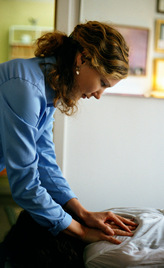| Sylvia Skefich, D.C. |
|
The tissues of the body can heal too tightly or too loosely when damaged. It is actually better in most cases, to heal too tightly rather than too loosely. Scarring often involves healing too tightly. Scarring can be diffuse as in when a muscle-belly has been strained, and therefore heals by slow infiltration of diffuse tiny fibers. Or scarring can be quite well-localized and specific as in a surgical scar. This discrete scar type can tether on delicate inner structures, either creating pain or inhibiting natural function of organs, nerves, or muscles. In these cases, there are a number of approaches to take to correct the situation: soft tissue manipulation of muscle or even organ structures (called visceral manipulation), active stretching of the involved site, and ingestion of proteolytic enzymes in order to break down the scar tissue. Proteolytic enzymes are those enzymes that break down proteins. Scar fibers are made of protein. Serrapetase is the strongest, although other exists (like bromelain and papayain). These enzymes must be taken on an empty stomach; otherwise they will break down the protein in your food instead of going systemic in your blood stream. It can take months for full effectiveness, but can be worth it when needed. To heal too loose is a complicated thing. Healing too loose often involves a ligament that has had a stretch injury like a sprain. Ligaments go bone-to-bone, and are deeper structures than muscles. When they heal too loose, the muscles take over the job of holding the joint together and then the muscles get overworked. For the short term, this can lead to sore muscles, and not just over the injured joint. For instance, and ankle roll strain, can lead to the outside shin muscles getting tight, which can affect the knee or upper shin. Over time, overworked muscles stiffen up and can move the bones around. Even a little wrong movement in a joint can create an arc of motion that hurts or feels wrong. If you have a stretch injury of a ligament, there are things you can do to heal the best possible way. Taping the area, or even bracing may be useful (in order to heal in a shortened position, and to not recreate stretch injuries in daily living). A professional would help you with this. It may be necessary to tape or brace for 5 weeks, depending on the injury, because that is the typical course of healing for a ligament. Nutrition will speed the healing process too: minimally, manganese and vitamin E to help ligaments heal. (We carry “E Manganese,” and “Ligaplex I” by Standard Process in the Vitamin Shoppe.) Icing and elevation can be useful in the initial stages when too much inflammation is a problem (which creates stretching from the inside-out). For icing, leave on past the point of pain and into numbness before removing the ice for best healing properties, up to once per hour, or at least 2X per day. Also for inflammation, enzymes are very useful, not only to only stop the inflammation process but to clean up the debris of this chemical cascade. They are as useful as NSAID’s (aspirin, Tylenol, ibuprofen) for inflammation pain but with no side effects. Sylvia Skefich is a Doctor of Chiropractic. She has an office with a public Vitamin Shoppe that carries an assortment of enzyme products at 920 41st. Avenue, Suite G (rear entrance) in Santa Cruz. 831-475-1995 www.vital-you.com
|
Doctor of Chiropractic, Sylvia Skefich – Santa Cruz, California 831-475-1995 |
